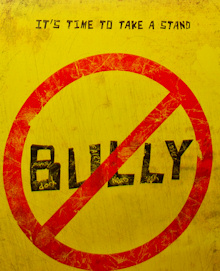2020 February
2018 December August June February
2017 December September June March
2016 November August June March
2015 December October July May February
2014 December October July April February
2013 December October August May February
2012 December September July April February
2011 December September July April February
from the April, 2012 issue of Kiai!
Justin Bieber's Gentle Giant?
By Kate Webster
Director of Violence Prevention Programs
Recently, the epidemic of bullying has received lots of media attention connected with the nationwide release of the documentary Bully – chronicling the harassment endured by five lower-middle class students in rural Southern and Midwestern US towns. With bullying on my radar, I was reminded of an incident from last year when a 9th grade student from Sydney Australia, Casey Heynes, fought back against his bully. In a 45 second video clip, viewers see Casey turn his cheek when he is slapped in the head, then block several more punches before he finally reacts, picking up the much shorter and thinner bully, raising him up over his head and slamming him to the ground. When the video clip went viral, individuals all over the world applauded his courage and ability to finally fight back. Some went as far as to call him a gentle giant. The entertainment industry even got into the act. Teen idol Justin Bieber gave Casey front row seats for his concert in Sydney and brought him on stage for an anti-bullying PSA.
 Casey’s story follows an all too familiar tale of unchecked bullying, loss of friends, and loss of self-esteem. In an interview on Australia’s A Current Affair, Casey revealed that he had been relentlessly bullied for 3 years – including being called “fatty” and having water balloons thrown at him – often on a daily basis. In his words, the eight friends he had upon starting high school all “ditched” him once the bullying ensued. Additionally, his father disclosed that he wasn’t even aware of the bullying and, while his sister knew and gave him emotional support, she was at a loss as to how to stop it. The role of the school was not mentioned, other than it being labeled a “problem school” in a tough neighborhood of a suburb of Sydney. Casey clearly was isolated and felt totally unsafe at school.
Casey’s story follows an all too familiar tale of unchecked bullying, loss of friends, and loss of self-esteem. In an interview on Australia’s A Current Affair, Casey revealed that he had been relentlessly bullied for 3 years – including being called “fatty” and having water balloons thrown at him – often on a daily basis. In his words, the eight friends he had upon starting high school all “ditched” him once the bullying ensued. Additionally, his father disclosed that he wasn’t even aware of the bullying and, while his sister knew and gave him emotional support, she was at a loss as to how to stop it. The role of the school was not mentioned, other than it being labeled a “problem school” in a tough neighborhood of a suburb of Sydney. Casey clearly was isolated and felt totally unsafe at school.
Describing his mindset during the incident, Casey said he just wanted the punches and slaps to stop, and then he “snapped” – seeing no option to a violent retaliation. While his reaction surprised thousands of people, as a self-defense instructor and a person who has studied data on how victims of repeated violence behave, I don’t find it that surprising. When people who’ve been abused retaliate violently, they typically are isolated, lack support, and like Casey, feel that they have no other options. In some ways, the issues are similar to cases of women who experience prolonged intimate partnership abuse. These women are often isolated, financially dependent and the sole caretaker of their children. Some of these survivors recount that, seeing no options, they too “snap” and harm or kill their perpetrator in retaliation. In fact, according to several studies on women in prison, between 40% to 65% of women incarcerated for murder claim that it was in self-defense against their abuser.
A sad truth is that most victims of bullying and abuse receive no training – training that would definitely increase their options and perhaps enable them to craft non-violent, but effective responses to violence. At Thousand Waves, it’s our mission to provide such training in both our martial arts and self-defense and violence prevention programs. In a new initiative for 2012, our Center created five special Self-Defense Days for our young elementary and middle school members. Participants included kids, parents and teachers all talking together about A Self-Defenders Rights and Responsibilities and How to Set Boundaries to Keep Yourself Safe. In our Five Fingers of Self-Defense programs, we frame our teaching around the "ethic of least harm.” In role-plays, students practice speaking up in the face of verbal violence, learning how to adjust their intensity to match but not inflame the energy being directed at them.
Interestingly, when asked if he’d recommend others doing what he did, Casey replied without pause that he would not – that the best thing to do is walk away. In fact, he had turned the other cheek many, many times before, but the problem only got worse. We believe that if someone is being hit and punched, as Casey was, they have the right to use physical self-defense tools to fight back so they can get away and get help. But we also encourage our students to take action earlier, when the disrespect or harassment is new, when non-violent responses have a greater chance of being successful. In Casey’s case, the outpouring of support has dramatically changed his life and his perspective. His father reported that today, Casey walks more upright, smiles more frequently, and laughs much more – being the gentle giant he perhaps truly is.
